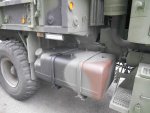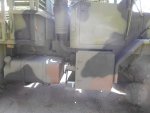I like the tank discussion, as I have been thinking about it. I am currently not cool enough to be an owner of a MV yet, but I do have an 89' Ford F700 as a toy hauler. On that truck I have 3 30 gal tanks, all tied together with the "low hanging crossover hoses". With a full 90 gallons of diesel I have personally run into the issue of parking on a slight slant and find fuel dripping out the breather on the low side tank cap. To keep this from happening, I just have a spigot style valve at each tank that I close when off road or have parked on uneven ground (to stop the equalizing), but I can open them all up and run 500 miles without refueling on the highway. To protect the fuel line that runs from one side of the truck to the other I just ran it through a piece of tubing welded to brackets on each side. It not only supports it, but keeps it at a level above the ground that I know won't be in danger of snaging. This is not a 4x4 truck so I don't get crazy with it.. but that doesn't stop me from finding some gnarly camp sites.
Now.. for a new idea. Do any of you guys know how fast the fuel returns to the tank? or how much volume is being dumped back? The reason I ask is that since I turn wrenches for a living (on German kraut wagons and the like) I am noticing more and more fuel tanks balanced over the drive shaft in AWD and RWD cars. Better weight distribution and blah blah blah.. but the pickup is only on one side of the tank. So you end up with 5-7 gal of gas that is lost on the wrong side of the fence. To fix this they run a suction jet pump on the far side of the tank. So...... fuel returns from the rail (or HP pump in our case) and goes into the tank at the pump, then runs into the far side of the tank where there is a one way check valve on an angle to the return line (low pressure zone caused by the moving return fuel draws the fuel from that side of the tank over with the return fuel), then that exits the return line at the fuel pickup side. This system passively pulls the fuel, as long as it is there, to the feed side, till it runs dry. Then it just slightly aerates the fuel from that point on, but it is so minimal it is negligible. The one way valve keeps it from transferring back when the car is shut off. To keep this system working the same, you would still need an open transfer line between tanks but it could be at the 3/4 mark instead of the bottom. That way the primary tank doesn't overfill when all tanks are full. If I am rambling, or you are lost, I apologize.. I can try to draw a picture. haha It sounds like a lot of work. And it sounds complicated. But it is not, I promise. I think it is a system that, once set up, you can forget about it for a long time. One pickup, one gauge, one tank that fills both at the same time when at the pump but will feed back to the primary tank without switches or low hoses.
ok. I am done now. Thanks for reading my book.






